
Feng Zheng Jie
“In a more Freudian idiom, it is a feeling prompted by the return of
the repressed. Freud did, however, discuss the uncanniness of the life-like automaton, Olympia, that figures in
Hoffmann’s tale, ‘The Sandman.’ The disturbed protagonist, Nathanial, is taken in by the doll and
falls in love with her. Freud explained that since children do not strictly distinguish between the
animate and the inanimate, they are inclined to think their dolls or stuffed animals are alive. As
adults, then, the sight of a life-like automaton or automatic human behavior reactivates the
infantile belief that we thought we had surmounted. Nevertheless, Freud argued, it is not Olympia
that makes Hoffmann’s tale so uncanny, but rather the frightening figure of the Sandman who,
young Nathanial is told, throws sand in naughty children’s eyes so that they jump out of their
heads. The fear of losing one’s eyes is associated with the fear of castration so the story
unconsciously, obscurely, reactivates that anxiety.”
& from the same article…
Freud psychoanalytically accounted for the uncanniness of the double: in infancy, we create a double as
an insurance against the destruction of the ego, which, once repressed, can later return and
reverse its aspect becoming ‘an uncanny harbinger of death.’ Mirror reflections and shadows are,
of course, another sort of double and have the same ambivalence.”
Margaret Iversen, “Catalogue for The Uncanny, Tate Liverpool.”

Jake and Dinos Chapman
“…as the queer theorist Tim Dean has illustrated, we are dealing with a regulation of pleasure—a process of medicalization that tells us which kinds of pleasures are acceptable and which are not.
I suspect that beneath our society’s desperate attempts to minimize risk, and to prescribe happiness as an all-purpose antidote to our woes, there resides a wretched impotence in the face of the intrinsically insecure nature of human existence. As a society, we have arguably lost the capacity to cope with this insecurity; we don’t know how to welcome it into the current of our lives. We keep trying to brush it under the rug because we have lost track of the various ways in which our lives are not meant to be completely healthy and well adjusted.
At such moments, what is fierce and unapologetic about us undermines our attempts to lead a “reasonable” life, causing us to follow an inner directive that may be as enigmatic as it is compelling. We may not know why we feel called to a new destiny, but we sense that not heeding that call will stifle what is most alive within us.
Unfortunately, we live in a culture that finds such insurrections threatening, not least because they make us less predictable and therefore harder to control. This is one reason we’re constantly reminded of the importance of leading a happy, balanced life—the kind of life that “makes sense” from the viewpoint of the dominant social order. Many of us have, in fact, internalized the ideal of a happy, balanced life to such an extent that we find it hard to imagine alternatives. As Freud has already claimed, there is little doubt about what most people want out of life: “They want to become happy and to remain so.”
A quick survey of our culture—particularly our self-help culture—confirms Freud’s observation. One could even say that, in our era, the idea that we should lead happy, balanced lives carries the force of an obligation: We are supposed to push aside our anxieties in order to enjoy our lives, attain peace of mind, and maximize our productivity. The cult of “positive thinking” even assures us that we can bring good things into our lives just by thinking about them.”
Mari Ruti

Michael Kenna
I will add one more quote here, from Arno Gruen, a German psychoanalyst:
“Adaptation to the power needs of parents leads to a split in children’s psychic structure, seperating their interior world from its interactions with the environment….in order to share in the power that subjugates them, children substitute obedience and adaptation for responsibility for their own actions. If we lose the connection to our own interior world, then we can relate only to a false self, to an image-oriented self attunted to the behavior and feelings pleasing to our surrounding world.”
I have always felt a fascination with marionettes, and with puppets to some degree, but more with marionettes. But also with all manner of dolls, figurines, and automata. This may just be, in part, the province of the only child. And perhaps additionally the sickly only child. My memories were always times alone. That’s what I remember. And I think children in any orphaned situation, and that can be literal or metaphorical, are going to end up with toy soldiers or little figures of animals, or with dolls. Now, I have also always felt there was a direct and clear connection between what Freud called the “uncanny” and with the reasons for art even existing. Earlier on this blog I quoted a bit chunk from Von Kleist’s essay on marionettes. Now, I wanted to discuss the uncanny again, but in light of both what Mari Ruti was writing, and also with Arno Gruen’s book, his first translated into English.
This goes back though, as almost everything does today, to neo liberalism, capitalism really, and how the current western authoritarianism is manifesting itself. There is a master narrative in the West today, which demands that one win and not lose, and that one be “happy” while doing it. Now one creates the other. If you win, you are wealthy, and if you are both those things, you must then, logically, be happy. And the ruthlessness of this society is distilled into the very elite 1%, but it is expressed by all those who want to be and envy that elite 1%. Now, I recently watched the new BBC pilot episode of the latest remake of Dumas’ classic novel, called (in its current incarnation) The Musketeers. I only mention this because one of the hallmarks of the world of Dumas and D’Artagnan et al, is honor. Never mind most of Dumas is gone in this new version, or distorted (D’Artanan is no Gascon, and certainly not a teenager…in fact looks more like an aging male model..aging being a relative term, mind you) and that historical anachronisms are now so normalized that they have ceased to have any impact, interpretively, as anachronisms. This was the chivalric code, the entire frame for masculine integrity, or masculine maturity, was *honor*. Without belaboring the point, in this new show we meet one of the Musketeers as he is found cheating at cards. It is treated ironically, and as a sign of “cool”. This is the training of the public. Bush and Cheney weren’t bad, just cunning. Obama didn’t lie, he just bent the truth. He was clever, and sly, but nobody mentions honorable. For honor is gone. And I think actually this has been a topic for American fiction writers for a while now. From McCarthy, to Richard Ford, to Denis Johnson and Kem Nunn. And it managed to last as long as it did because of the dime novelists and pulp crime writers (James Cain, Chandler, and Hammett). But I digress…because I want to return to the writ of “happiness”.
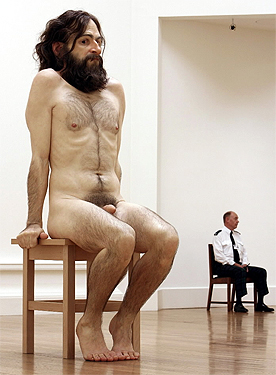
Ron Mueck
First, I happened to read Frederic Jameson on film (it was on facebook, posted by a friend) and specifically on Boorman’s 1964 sci fi film Zardoz. This essay touches on a number of things I think are related. One is the self help industry, and the way in which much, if not most, of psychoanalysis changed upon arrival, as it were, in North America. The uncanny and art (including dolls), the cult of happiness and pop psychology, and the larger sense of de-politicizing discourse, and that, along with intensified measures of social control, a society that cannot express mourning, or feel guilt. Laurence Rickels, the Freudian social critic has written on this idea of mourning. But for the purposes of this posting, I was struck with two things in the Jameson essay (and there are many topics within that one essay) http://www.ejumpcut.org/archive/onlinessays/JC03folder/ZardozJameson.html
The first was the idea of all the many post apocolyptic narratives out there today (mostly in film, but for literature as well) and how they all have both expressed a ruling class contempt for the masses, and a desire of the masses for the end of these socities of control. People who believe in Capitalism, trust the government, the affluent bourgeoise, may still habor semi-secret desires for a return to some primitive eco system and fantasy hunter gatherer society. But the other thing is that science fiction is almost always reactionary it seems to me. There are a whole basket full of geeky leftist types (meaning crypto reactionary)who love to pimp Sci Fi as the most revolutionary of forms. Honestly, this shouldnt even require a rebuttle. But this does connect back the marketing of youth in western Capitalism today. The prolonging of adolescence and that within this marketed image lies both the denial of death, and more acutely the inscription of success and happiness as always taking place in a, and on a, youthful body. The training of desire, the creation of coping mechanisms, and the basic trauma of our childhood, however one dissects that, form an oppressive systemn designed to create passive self deluding complient workers. A manufactured idea of “youth” overlaps with this manufactured idea of “happiness”. In the Boorman film, like almost all such Utopian constructions, there is this equation of sexual potency with instincts and lack of intellect. The rulers are all mind, as their bodies atrophy, and many become infected with apathy. Sean Connery appears as the bringer of seed, but also of physical strength and war like proclivities. I think Jameson probably over determined this to a degree (especially regards 2001 Space Odyssey). There are certainly curious and interesting things in the Boorman, for all its campiness… but it remains fairly conventional in its depiction of man as, finally, an animal, and one that *needs*, it seems, to fight, if only to achieve sexual arousal.
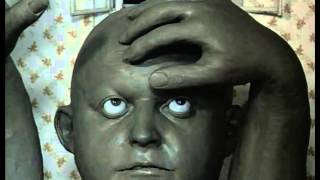
Darkness Light Darkness, 1989, Jan Svankmajer, dr.
Daniel Tutt wrote, in a blog post discussing the self help industry…
“The self-help discourse, while often seeming to advocate a break with this regime of narcissism often goes to reinforce it. How could it not? In one popular book of self-help, The Four Agreements, we are advised to never take anything anyone says personally. In Barbara Ehrenrich’s Bright-Sided: How Positive Thinking is Undermining America, we are presented with the brutal underbelly of the self-help discourse. The manuals for self-help in the economic downturn sound more like self-defense instructional’s for shrugging off toxic co-workers, for securing your sphere of influence, for forcing you to simply use positive attitudes to overcome our suffering.”
Today, the culture industry obsessively presents these simplified narratives in which masculinity is valorized through physical strength, but also through brutality, and yet, just think happy thoughts and you’ll be happy. The erosion of compassion and empathy is connected to not just these cartoon-like narratives of police and state authority, but through presenting ideals of success and happiness that are also individualized and achieved through denying others what you want, and through magical thinking. Cooperation and sharing and probably the least visible tropes in mass media product. Now, add to this an idea of Puer aeternus, of youth being somehow granted to one not by natural processes but through technology and capital. One can only be youthful if one enters into the marketplace of desire. What Gruen describes as the child’s learning curve, the abandonment of ourselves, of our organic inner life, our sense of wonder, then the later experiences of ‘the uncanny’ suggest its importance as a portal to our dream life, the unconscious memories, or glyphs of some archaic trace element of our collective selves.

Momento Mori, Peru. Date unknown, photographer unknown.
But also…..per Jameson here:
“…it is characteristic of the entire West today, whose dominant convention in this realm is rather the dystopia, Utopia gone wrong like some nightmare of berserk machinery. In dystopia all the features of order are mustered to create the ultimate straitjacket for the human instincts, if not the human spirit. But we should take into consideration the possibility that this repugnance of our society for the Utopian vision may itself be an ideological symptom rather than a genuine historical and ontological recognition. Marcuse is, indeed, only the most recent to have denounced the anti-utopian inclination of our society as a key feature in its repressive apparatus and structure. It seems to me axiomatic that the refusal of Utopia—whatever motivation is given (e.g., excessive rationalization, atrophy of the physical, planification and totalitarianism)—is always a code word or disguise for refusing socialism. “
Again, the idea of sharing, of empathy and of the working out of ideas of social trust and honor, are what is really being erased. History is always (as Jameson suggests later) the scene of outsider hordes rampaging, usually on horseback, to pillage and rape. History is reduced down to conquest. The effects of various themes being normalized has also had an effect, directly, on the public’s ability to read messages. What seems to be constantly forgotten is, as I wrote last posting, the ability to identify the enemy, but also to recognize a wider context than that which is provided by western revisionism and propaganda. I had a debate about old Soviet posters, early ones, in support of African independence. Criticism was leveled that many were images of white saviors. Now, this is the accidentally reactionary side of a usually cogent and neccessary critique of race. In fact, if you are looking at posters supporting international socialism, and few (only a very few, in fact) center white Russian figures, the fact of the ideological backdrop of the message is being ignored. The message was support for anti Imperialist and anti colonialist movements of independence in Africa. The message was the opposite of the accusations. So foreign is the message of solidarity and unity today, that anti Imperialism goes ‘unread’. But it is also the self congratulation of the critic, a sense of agreement with those who make similar (usually correct, and neccessary) criticisms of mass culture or marketing, etc. It becomes almost a knee jerk prophylactic criticism. For what is the point of the accusations? The point is to show white supremicist imagery in both private sector marketing and in state propaganda. And in almost everything that comes out of the United States for the past fifty years has been and remains white supremicist. But here are posters from a socialist state (never mind for the moment how well this state delievered on their promises) indicating only support and assistance for self determination, for equality. To not grasp or read the difference between leadership and paternalism is striking. But such are the effects of eighty years or so of Western anti communist propaganda, plus a constant framing of capitalism and Imperialism as almost natural, that these posters are read as if they were produced by the US government. The Soviet experiment is examined in the same cynical light as the US imperialist state. And, the criticisms situate those making them alongside the most right wing apologists for Imperialism. The critics are anti Imperialist in theory, but they cannot read the image because they lack the historical understanding, they have only learned, in most cases, what the Western educational system (TV, Hollywood, the state department, and ownership class) has told them.
http://www.buzzfeed.com/marcjaysonc/29-astounding-soviet-propaganda-images-promoting-r-ffhg

Rainer Fetting
The claims of exoticism, and otherness would seem cynical, too, in the context of their creation. Those criticisms are made of the material of western Imperialist and colonialist domination. Resistance to and criticism of western orientalism is one thing, but to look at these posters at the very least demands a more nuanced reading of the forces behind their production. They were not for profit, they were not part of an Imperialist agenda. I am reminded of what Ernst Bloch wrote: “Nazi’s speak deceitfully to people; communists quite truthfully, but only about things”. I suspect many in the West have developed an aversion to emotionally mobilizing the political subject, because of decades of PR and marketing from corporations and the State Dept.
This touches on post apocolyptic narratives in a way, too. For so deeply is the trope of Imperialism, and capitalism into all narrative that all restoration narratives take on reformist echos.
The idea of honor is an interesting topic in light of all this. Certainly in the manufactured narratives of the Spectacle ‘honor’ is demeaned as childish or naive. Once again, winning trumps integrity. Cheating at a card game is acceptable, even “cool”, if you win. And the invention of “cool”, or rather the co-opting of the idea, the appropriation of “cool” into a marketing tool has made of it just another individualized accesory for self branding. Cool was once an oppositional under class, mostly black, aesthetic. Now, it is marketing. Anti authoritarianism is expressed only in advertisments, not in reality. It is made into a substitute gratification.

Gabriel Metsu, “The Sick Child” 1660
The uncanny disrupts the self help narrative, the glossy smiley face optimism of a therapy culture predicated on self interest…the better to line up with Capitalism. Adjustment to the status quo. Happiness is only adjustment, finally. The uncanny gnaws around the edges of these assurances. But the uncanny appears not just as a double, a dopleganger, but in anything that creates an fissure or break from sensory habits. As a small digression here, it is worth looking at a couple remarks Benjamin made in his notes (but not included in) for his essay on Art and technical or mechanical reproduction. He wrote..“Film is the art form that corresponds to the intensified threat to life which modern man must look in the eye. The need to expose oneself to shock effects is man’s adaptation to the dangers threatening him. Film corresponds to profound changes in the apparatus of apperception…changes that are experienced at a personal level by every pedestrian in big city traffic, on an historical scale by every present day citizen.” He also wrote of the actor performing for the camera, and that the director stood (though this is really not true, but still interesting) in the same position as the director of a laboritory experiment. But this takes one to the topic of the “expert”. The rise of the expert as an idea came out of the more regressive side of Soviet thinking. And the expert soon became the specialist. Krakauer saw Fordism as ushering in a crisis of knowledge, that increased reliance on specialization meant that the background against which specialized observations rested was left to atrophy.

Evan Penny
Benjamin sought to redeem the idea of expert from its dependency on instrumental thinking. The fact of technology created a tension in Benjamin, for he was drawn to technology, but was suspicious of his own attractions to it. But for the purposes of this posting, I mention this for it touches upon the hyperbranded reality of today, in which everything is processed as if its a film. If there is any truth in what Benjamin described, then the adaptation to the assaults of social domination by the state, and its corporate tools, makes a certain sense.
But back to the Boorman film for a second. Arno Gruen has said that only destructivness makes people feel alive, as a result of the self betrayal of children to share in the morbidity of their parent’s envy of and desire of power. If one sees this as part of an inculcating of Imperialism and training in domination, meaning white domination, and almost always male domination, then I think probably the outlines of Gruen’s theory is correct.
Now, there is something of a question here about the uncanny in relationship to the digital world of constant image circulation. Has the uncanny changed or evolved somehow? When Benjamin describes the photographs of Eugene Atget, of empty Paris streets, as resembling the scene of a crime, he is also describing what he saw as the loss of the auratic. There is something missing in Atget, besides people. But this also brings to mind the portraits of August Sander, and later Mike Disfarmer. There is something uncanny in both, but it is expressed in the tension between what has been taken out and what is present, a heightened presence. Benjamin famously wrote of how early photographs of unknown people touch us because they represent a buried layer of history, of the past. I think though this is incomplete, for it is the missing narrative that really creates the uncanny. There is also, and this is more to the point, the effect on the viewer of an engagement with a pre-existing relationship to commodity recognition. The mass produced image, whether an advertisment or just a viral facebook meme, carries with it a deadness that links to its commodified role. The viral meme may not be selling anything, except of course it is, by way of the harvesting of attention, but in any case its reproduction implies death. The potential for commodification is like a quotation from a realm of domination. Now, if one looks at the work of Greg Crewsdon or even Thomas Demand, in which highly choreographed and artifical situations (for Demand, it comes via his elaborate paper constructions of rooms and hallways, which he then photographs) never feel uncanny, in the same way, for me, David Lynch is never uncanny. One cannot intentionally create the uncanny. It seems to appear independent of authorial intention. Why is this or how is this? Well, firstly, even as I write that sentence I realize the need for a definition of “intention”. The author or artist can ‘intend’ accidents. Action painters were leaving a mark of their gesture, their action. Again, however, accidents are never accidents, and here we return to Freud.

Modena Cemetery, Aldo Rossi architect
It may just be that the uncanny is the residue of fear. The fear of the author, the artist, and there is a distinct quality of mortality, of finitude, and that fear carries with it something of our archaic past. This is what haunting is, finally. The ghost is our own fear, and in a mimetic process of re-creation the fear and the mourning and the grief of our own life is given a narrative. But what are we afraid of? In a sense, nothing. The missing or insufficient element in almost all critical writing on painting or photography is narrative. And narrative is always connected to, and informed by material history. The politics of the uncanny is expressed from within this dynamic.
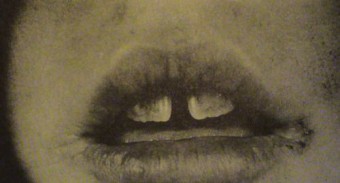
New Illustrated Medical and Health Encyclopedia (Cracked mouth).

Jean Paul Riopelle
I would argue, to return to the uncanny (and to art) again in all this, that even in abstract or minimalist painting, what seperates the good from the bad (sic) is the appearance of the uncanny. In one sense, this is the surfacing of the dream. So the uncanny has a political dimension, though, in the sense in which layers exist in different classes, emaciated social forms, and memories or fantasies of these social forms, which still occupy the dream work of people. What is most scary in the 21st century West is that so much dreamwork seems to be made up of the debris and psychic by-product of the culture industry. The failure of the new snarky left is to valorize this debris rather than to implicate it for its role in social domination. This raises complex philosophical questions having to do with historical time, and the time of lived experience. Georg Simmel wrote, in 1916, a tretise on “time”, in which he suggested that calendar time, this image of a continuous sequence of eras, can only become historical understanding through empathic understanding (it’s a good deal more complex than this, but …for now, this will do) but that there is a contradiction inherent in this which has to do with empathy itself being historically mediated. I would argue, that so it is also with the uncanny (and dreams). Simmel sought (and this is taken from Frederic J. Schwartz’s brilliant book Blind Spots) to reconcile this contradiction by the ability to grasp a totality of history (or a portion of it) so that an outside is created, an Archimedean point from which events can be viewed. There is something in this model which feels correct as far as cultures go. The outside is also, always, where the unrepressed exists. One is both accessing the unconscious memories of one’s self, and the archaic traces, the elements of allegory.

Joel Sternfeld
The conclusions to this set of questions is, really, that each generation lives out its engagement with artworks from within a set of formal structural possibilities. I will leave off here, for this is endlessly complicated, and return to the idea of the uncanny. One implication of even asking these questions is to raise the issue of causality. For their seems both a regressive and progressive side to understanding causality. It is worth noting that Bloch wrote on the Simmel tretise using a Marxist construction of that Archimedean point (which was, in fact, really a term used by Panofsky….but anyway…) defining relations of production as a baseline. In other words, to understand historical cultures and art, one must define the dominant mode of production and the social relations corresponding to it. In other words, it is an ideological analysis of history. This is not, however, for Bloch, a historical materialist philosophy. It is far expanded beyond that. One of the things that came out of these debates was the sense of time becoming spatial, and made visible. And perhaps no more so than in archtecture. What is fascinating in this, because politics played out in the so called “battle of the roofs” (flat, or pitched) and in what Bloch called, perjoritively, the “uncanny” experience of the Neues Bauen (which featured many who later worked at the Bauhaus). Bloch saw the uncanny as a form of homelessness. He saw too much of a machine aesthetic at work in the shiny flat surfaces of the facades. I would fault Bloch here, as I do with him in a number of matters, but his points are worth noting. Bloch saw capitalism and fascism as one, essentially, but also faulted social democracy (via a perspective built on the foundation of the 3rd International). There is value in his critique I think, but his default position was an idelible anti-modernism, a penchent for the same volkisch-expressionist neo-primitivism that Heidegger so fancied, and who Bloch hated. Such are the contradictions of the politics of space. So, the uncanny continues to surface in curious places, and it is linked also to mimemis (as is everyting in culture). Mimesis is a form of behavior, so wrote Adorno. It is also, I think, a form of thinking. The primal originary mimetic behavior links to language as well, but it is also, perhaps most importantly, an encounter with the ‘other’. And here those memories of history as rampaging hordes on horseback is re-stimulated. For mimesis leaves memory traces, and these are part of the building material of the uncanny. Mimesis is a contested topic whenever anyone discusses Adorno. And I think it is because of its mystical character in places. Benjamin saw one of the roles of art was to produce what is blind. Perhaps the most dense paragraph in all of Adorno begins with:
“The sense of form is the reflection, at once blind and binding, of the work in itself on which that reflection must depend; it is an objectivity closed to itself that devolves upon the subjective mimetic capacity, which for its part gains its force through its antithesis, rational construction.”
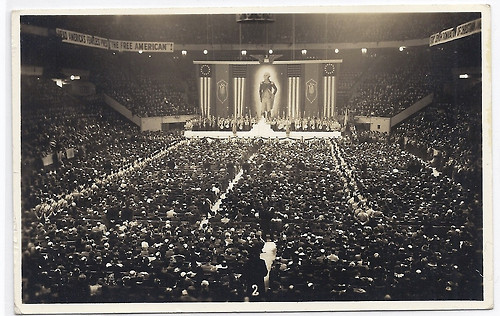
American Nazi Party rally, 1939 (German American Bund)
I intend to post about this soon, but for now, as this relates to the uncanny, I will limit the discussion a bit. Now Adorno also saw (and Schwartz is particularly good on this topic) that as music and theatre must be performed (again and again, in theory) to be interpreted, it is also true of all artworks. Artworks are self-likeness freed from identity — as Adorno put it — and that they are not simply, ever, ‘given’. They are relational and processural. And hence, I argue, narratives. All narrative is then, partially, an action of mimesis. Now, there is something close to a contradiction buried in all this (more on this next posting) that resides in art as the anti-instrumental form of thinking. It is a liberation from conceptual thought and regressive science, but the danger (and the contradiction) is that it then, logically, leads back to myth. As Schwartz sums it up; “If mimesis is behind the shudder of the new, the epiphany of utopia, it is also behind the descent into anti Semitism and barbarism.”
In this era of psychological risk management, in the hegemony of telecom and culture industry feeds, of homogenized narratives that valorize kistch and cliche, sentimental and jingoistic, the role of the uncanny looms large. There is also something to do with digital reproduction that has altered a certain valence of perception. Today most film is shot digital, its color corrected during shooting, and new technician positions are on-set all the time. If it took Hitchcock and Siodmak and Welles hours to light a scene, today its just digitally altered. The space at the back of the room in Hawks or Wilder or Ray isnt there anymore. Which brings me back to marionettes and dolls. A cartoon is not the same. Part of the allure of the doll and marionette is they do not come alive. They mimic life. They parody life, often. Digital and CGI have no air, no space, no weight. And soon that lack of air suffocates perception and emotion. The viewer must engage in the alchemy of giving a very specific kind of life to the marionette and doll. The pathos of early automata has to do with this same quality, really. The alchemist in us is put to work, and that is much more active and unconscious than watching The Amazing Spiderman.
One final note here on blaming victims. Because it links up with how empathy is stigmatized now. Bruno Gruen points out how propaganda that fuels hatred tends to be believed, while that (true or not true) that would arouse our empathy tends to be distrusted.
“Sometimes we blame the victims. They make us feel very uncomfortable; we are ashamed of our empathy because we hate the victim in ourselves.”
Bruno Gruen

Zhang Huan
He points out the Attica Prison riots as an example. The police who came to liberate the hostages were not concerned at all with the fate of hostages. He suggests that empathy is buried ever more deeply, is ever harder to access. There is a related phenomenon, that of artifical emotions. I suspect these are directly linked to mass media and electronic culture. A revisionist history that creates narratives of military heroism, and blots out stories of sadism and torture, is simply fitting into the default strategy to erase compassion and empathy. In their place these revisionist narratives create homogenous mini-narratives (narratives within narratives) designed for group agreement. The over use of the word “hero” is the perfect example. Today, insurance salesmen are described as heroic. Auto repairmen are heroic, etc. These artificial emotions, designer emotions or feelings, obviously hide sadistic and cruel emotions. Even murderous emotions. As Gruen puts it, “feelings that are not feelings can be recognized by the manifold forms of violence they generate”. This is the latent or hidden cruelty of the white liberal today, I think. The educated 20%, who function within a universe of artifical concern, or care, and this is EXACTLY what sentimentality is; a false unreal feeling of sympathy, that only barely hides the aggression underneath. Liberal conformity means adjustment to the master narrative, aggreement with the values and aesthetics of the system, meaning the ruling class. The bourgeois envy and desire of and for the rich is among the most strking things I experience in the West today. It often tips over into sexual maschoism, debasement and willing self humiliation…if a celebrity, or a member of the propriator class is involved. The gender split in this is worth an entire posting I think. This sense of aggression, directed at the “other” or against oneself, is both created by a system of domination, but also by our own increasingly battered inner life. One cannot be born into the nightmare of Imperialist violence, predatory capitalism, and inequality, and not suffer psychic battering.
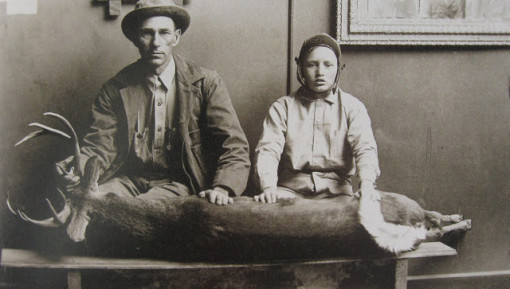
Mike Disfarmer

You have a very unique way of writing that shows a lot of Intelligence John. I like your style. I don’t understand ALL of it but I assume it would benefit me to keep reading and learning. Keep up the good work lol 🙂
Jacob
I’m struck by your post as usual. Really enjoyed your quotes and thoughts on post apocalyptic narratives as “reformist echoes”. I’m working as an extra on the set of “Hunger Games 12” or whatever. Sigh. This is a narrative as trashy and colonialist as any. My question is how the Western genre plays into this. I always felt (and my flick aims for this, however intentions are useless) films like Bad Day at Black Rock or even Man of the West seem to provide an anarchic uncanny split from such horrid tropes. The Western seems to put the outcast at odds with society in a way that can bring really useful narratives ?
I initially had the knee jerk reactions to the soviet propoganda and I wondered why… It seems a neo liberal mindset does not want true empathic depictions of “the other”. That it simply cannot exist. To me, part of the uncanny lies in an acknowlegment of the history of domination, yet also a blank space for what might be. A shedding of assumptions? Not sure, just sketching…
@jack
BD@BR is a terrific film. I used to screen that at the film school, just for some of the way it was shot and edited. But both those films are reworking some sort of mythic ideal, man of the west is Lear mixed in with a few other things. Its a very dark film,. too. Its about family and lonliness and fate. And thats probably what feels so different from most material today. That fate was a force somehow. Both are good genre films, in the very best sense of that word. Its an interesting observation, linking the uncanny to domination. I do think the way adorno described the song of birds as containing echos ….portents…the memory of , in fact, primary aggression. I dont know…..its easy to sort of romanticize an aspect of that, but…..I have to think about it more.